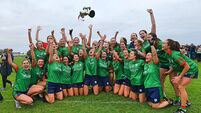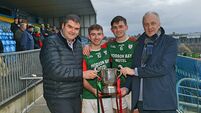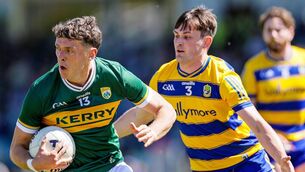A championship won on St. Brigid’s terms
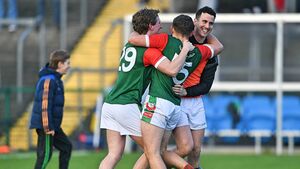
WE DID IT: St. Brigid's players celebrate the club's 19th Roscommon senior football championship success following Saturday's replay against Pádraig Pearses at King and Moffatt Dr. Hyde Park.
In a county final that will be remembered for Conor Carroll’s brilliance and Pádraig Pearses’ missed chances, it is important to note that St. Brigid’s won this county final because this game, and the championship (more on this later), were played on their terms.
Yes, it is fair to say that the outcome could have been different had Pearses taken more of their half dozen sighters of goal. Twice in the first half, Frank Canning’s men could have moved five points ahead but each time Carroll was equal to the task, denying Eoin Colleran and Hubert Darcy respectively.
That second save altered the game’s momentum, and so it proved as Ciarán Sugrue wheeled away in delight seconds later, having kicked his side’s third point in a run of seven without reply.
Big games are decided by key moments and fine margins. Yet this county final was won by the team that got more out of their key marksmen than they did six days previously, and one that managed to deal with the opposition’s adjustments.
Despite another tigerish showing from Mark Richardson, St. Brigid’s managed to supply a greater quality of ball to Ben O’Carroll and, as a result, their attack purred.
O’Carroll was fortunate to get away with a double hop for his first point from play but his hold-up play and ability to generate space, which was on show for that score, were a joy to behold.
Conor Hand raised his level from the first day, while Bobby Nugent’s deeper-lying role helped him break onto possession and produce the touches of class his side needed in the opening half.
So, how did these three key players become more involved?
St. Brigid’s decisively won the middle third battle, which, in turn, gave them a platform to bring their key men into play. They also won that key battle six days ago but if this was a boxing fight, they would have claimed a 115-113 split decision verdict in the first encounter.
In Saturday afternoon’s replay, they secured a more dominant win, one that was more along the lines of 117-111 or 118-110.
This time around, Ronan Daly squeezed up on Brian Stack while Conor Carroll’s first two kickouts went short to Robbie Dolan. Yet, as the game went on, Carroll, more often than not, found solutions and usually it came in the way of targeting Eddie Nolan.
Pearses contributed immensely to two thoroughly enjoyable finals. Yet, they will reflect on how St. Brigid’s managed to shackle their key men. Once more, Seán Trundle was excellent on Paul Carey, while Ruairi Smith twice went about his business against Hubert Darcy with the minimum of fuss.
Meanwhile, Robbie Dolan, whose knee injury is a concern going forward, managed to keep the always dangerous Eoin Colleran to just 0-4 in over two hours of football.
Now that we have examined a small amount of the finer moments, let’s take a big picture view of the championship. There is a question to be asked. Do too many people — and I include myself in this — put too much stock in the two-pointer?
Let me explain. Out of the 30 games played in this year’s senior championship, 29 ended in victories for one side or the other. Out of those 29 games, only 13 were won by the team that kicked more two-pointers, or in terms of percentages 44.8 per cent.
St. Brigid’s are the perfect reason why we, as followers of the game, keep needing to adjust and adapt our reasoning in terms of what leads to success. After all, St. Brigid’s didn’t kick more two-pointers than their opponents in any game in this year’s championship.
Yet, the Fahey Cup will reside in Kiltoom this winter.
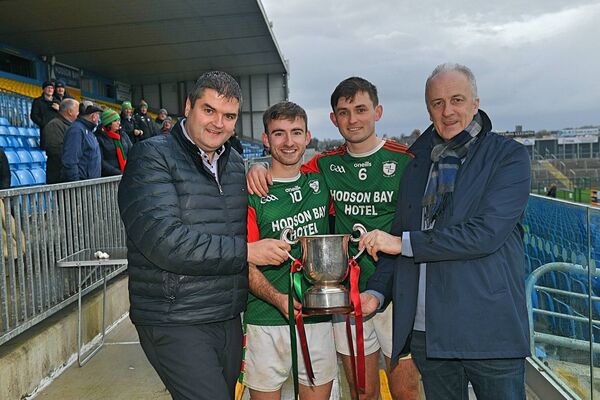
To break it down, St. Brigid’s are a supremely talented footballing side who possess key shooters that can cause death by a thousand cuts with their ability to score from 30 metres out or closer.
They have used this strength time and again during this campaign, with O’Carroll excelling in key moments and Bobby Nugent stepping up to the plate, particularly in the quarter-final against Roscommon Gaels and in last Saturday’s replayed affair.
The two-point arc has created more space inside and can lead to defences tiring quicker. Those two facts cannot be measured accurately by numbers alone but, perhaps, we need to reframe our focus on the two-pointer as a tool that can win a game, rather than one which will likely win a game.
Just to go on a slight tangent, another widely held belief is that a team must win the midfield battle if they are to emerge victorious. St. Brigid’s did come out on top in this sector last Saturday and, as mentioned earlier, it did help their cause.
Yet, a quick flashback to this year’s intermediate final disproves that midfield supremacy is a must to win big games. Éire Óg won the midfield battle hands down in last month’s final. Yet Strokestown are the side that are looking forward to a Connacht semi-final against Allen Gaels, and senior football next year.
In his excellent review of David Gillick’s new book, Irish Times journalist Malachy Clerkin claimed that journalists think they know more about how the mind of top level athletes works when he stated: “In reality, the prosaic truth is that much of the time you (journalists) don’t even know what you don’t know.”
Perhaps supporters and those of us in the media might need to remember the above quote when analysing teams in Gaelic football’s new age. Chances are we don’t know as much as we think we do but sometimes the excitement comes in feeling that we are moving closer, despite how much St. Brigid’s have shattered our pre-conceived notions.

